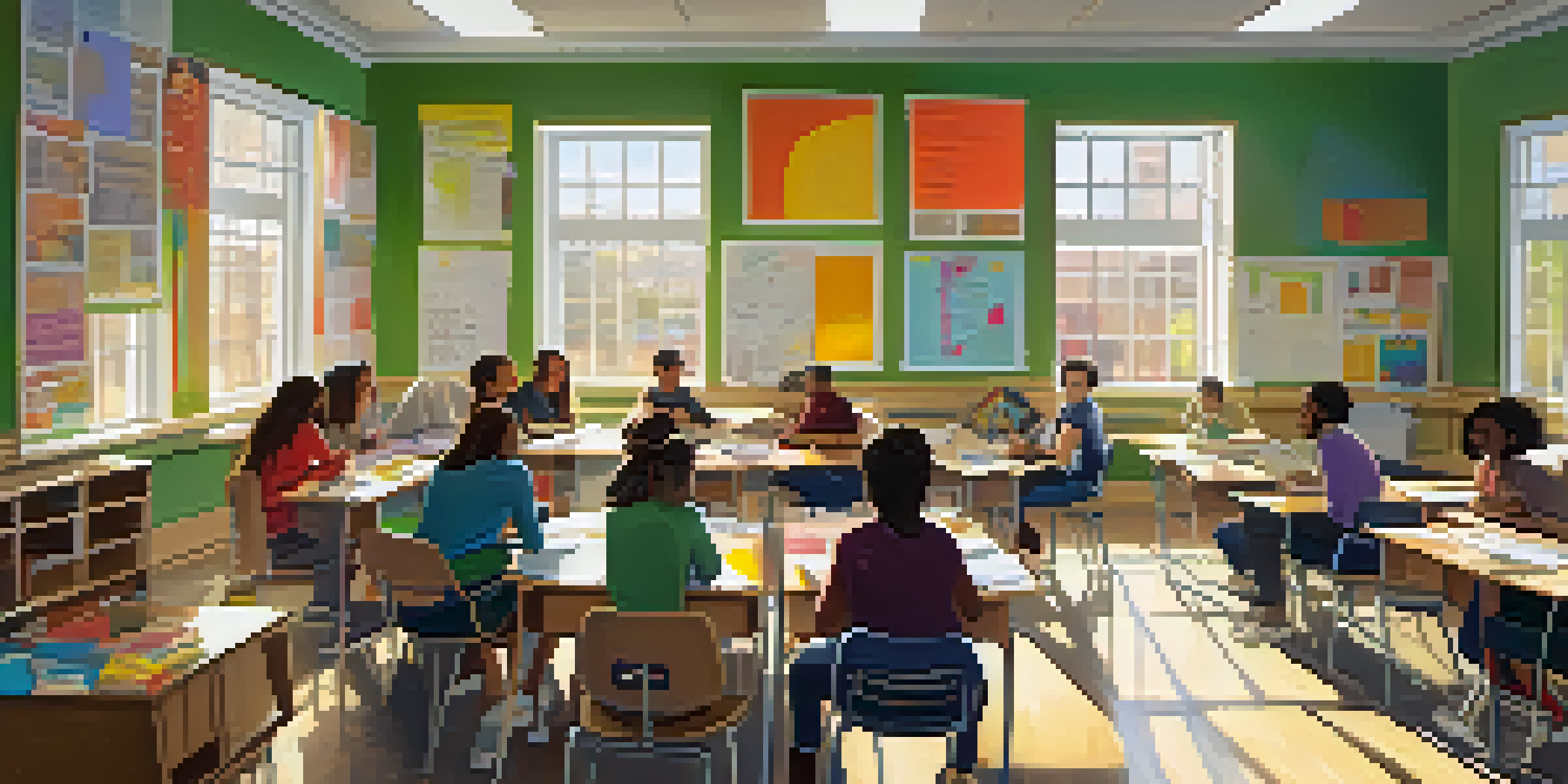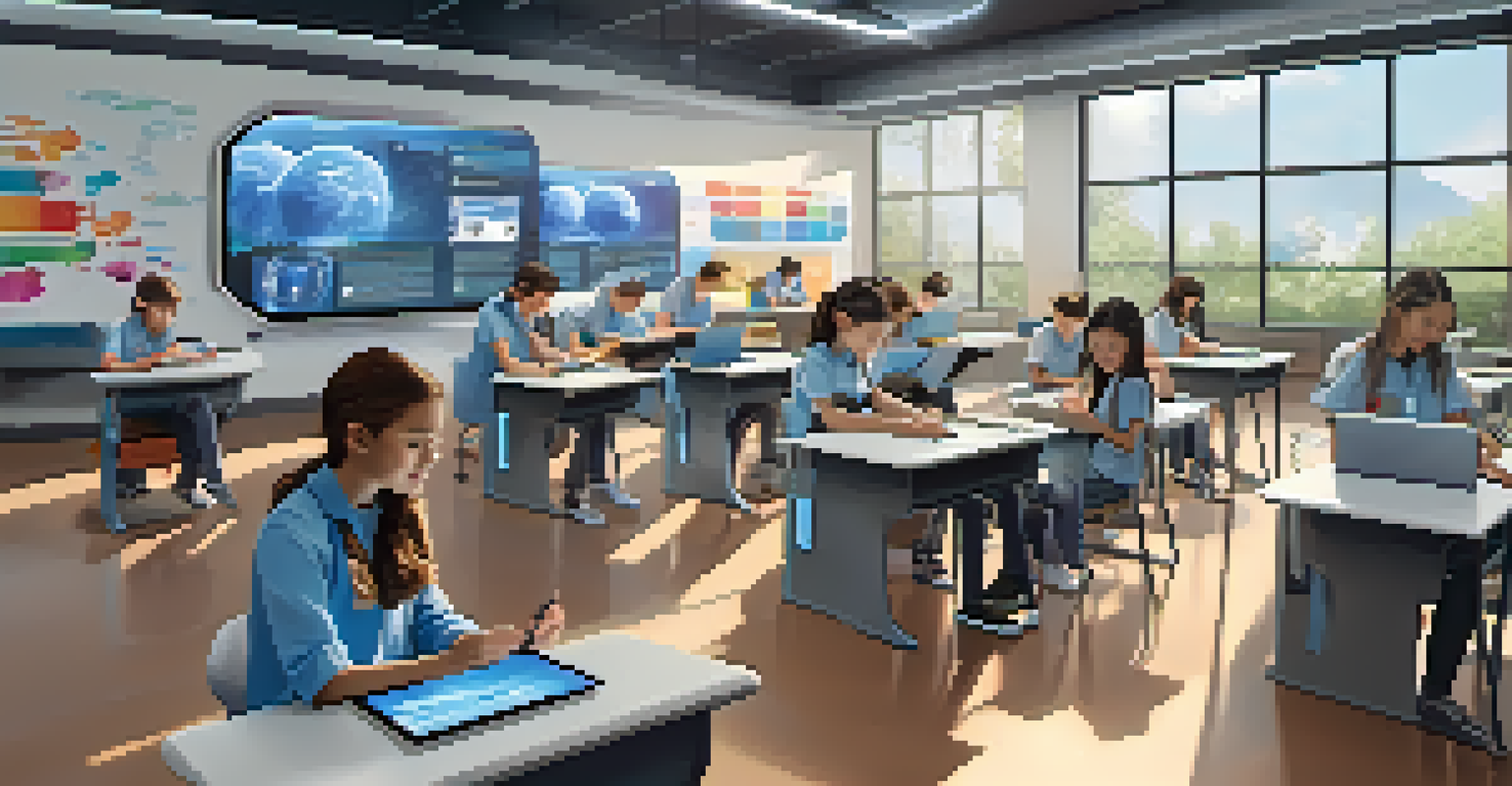Exploring Flipped Classroom Models in Blended Learning

Understanding the Flipped Classroom Concept
The flipped classroom model reverses traditional teaching methods, allowing students to learn new content at home and engage in interactive activities in class. This approach shifts the focus from passive learning to active participation, fostering a deeper understanding of the material. Imagine watching a cooking tutorial before trying the recipe yourself; this model prepares you for hands-on practice with guidance.
The future of education is not just about technology, but about the experiences that technology can create.
In this setup, students often watch video lectures, read articles, or engage in online discussions at their own pace. This flexibility caters to various learning styles and schedules, making education more accessible. For instance, a student struggling with a concept can revisit the lecture as many times as needed, transforming their learning experience.
Ultimately, the flipped classroom empowers students to take charge of their education, promoting self-directed learning. This transition from a teacher-centered to a student-centered model encourages critical thinking and collaboration, essential skills for the modern workforce.
The Role of Blended Learning in Education
Blended learning combines traditional face-to-face instruction with online learning, creating a more flexible educational environment. This approach allows educators to leverage technology while still maintaining personal interaction, which can enhance student engagement. Picture a classroom where students can collaborate on a project both in-person and through digital platforms.

The blend of online and offline experiences helps cater to diverse learning preferences, providing students with various ways to absorb information. For example, visual learners can benefit from video content, while auditory learners might thrive in discussions. This versatility can lead to improved retention and understanding of the material.
Flipped Classrooms Foster Engagement
This model transforms classrooms into vibrant learning communities, encouraging active participation and collaboration among students.
Moreover, blended learning prepares students for real-world scenarios where hybrid work environments are increasingly common. By integrating digital tools into their learning, students develop essential skills that translate directly to the workplace, fostering a sense of preparedness for future challenges.
Benefits of Flipped Classrooms in Blended Learning
Flipped classrooms offer numerous advantages, particularly within a blended learning framework. One of the most significant benefits is the increased engagement during in-class activities, as students arrive prepared to participate in discussions and collaborative projects. This dynamic transforms the classroom into a vibrant learning community, where ideas can flourish.
Education is not the filling of a pail, but the lighting of a fire.
Another key benefit is the personalized learning experience that this model provides. Students can progress at their own pace, allowing them to spend more time on challenging concepts or accelerate through familiar material. This individualized approach ensures that all students receive the support they need to succeed.
Additionally, flipped classrooms encourage the development of essential skills such as time management, critical thinking, and problem-solving. As students take responsibility for their learning, they learn to prioritize tasks and seek help when necessary, preparing them for academic and professional success.
Challenges of Implementing Flipped Classrooms
While the flipped classroom model has many benefits, it also presents unique challenges that educators must address. One significant hurdle is ensuring that all students have access to the necessary technology and resources. For instance, students without reliable internet access may struggle to engage with online materials, hindering their learning experience.
Another challenge is the need for educators to adapt their teaching styles and practices to facilitate this new model. Teachers must be comfortable with technology and create engaging content that captures students' attention. This shift can be daunting, especially for those accustomed to traditional teaching methods.
Blended Learning Enhances Flexibility
Combining traditional and online instruction allows for diverse learning preferences, making education more accessible and engaging.
Lastly, some students may resist this model, preferring the structure of conventional classrooms. To combat this, educators must communicate the benefits of the flipped classroom clearly and provide support to help students adjust to the new format, fostering a positive learning environment.
Key Strategies for Successful Implementation
To ensure a successful transition to a flipped classroom model, educators should start by setting clear expectations for their students. Communicating the goals of the flipped classroom, along with the resources available, can create a sense of accountability and ownership among learners. This transparency helps students understand their roles in the learning process.
Incorporating a variety of engaging content types is another crucial strategy. Educators can use videos, podcasts, interactive quizzes, and discussion forums to cater to different learning styles and keep students engaged. Think of it as creating a buffet of learning options, where students can choose what best suits their tastes.
Lastly, fostering a supportive classroom environment is essential for encouraging students to embrace the flipped model. Building strong relationships with students and providing ongoing feedback ensures they feel valued and motivated to participate actively in their learning journey.
Assessing Student Learning in Flipped Classrooms
Assessing student learning in a flipped classroom requires a shift in evaluation methods. Traditional assessments, such as exams, may not fully capture the depth of understanding that students gain through active participation and collaboration. Instead, educators can use formative assessments, such as quizzes or group projects, to gauge student progress more effectively.
Additionally, self-assessment and peer evaluations can play a vital role in the learning process. Encouraging students to reflect on their understanding and provide feedback to their peers fosters a sense of community and accountability. This collaborative approach helps students develop critical thinking skills while reinforcing their learning.
Technology is Key for Success
Effective implementation of flipped classrooms relies on access to technology and the ability to adapt teaching methods to new formats.
Finally, using technology to track student engagement and progress can provide valuable insights into their learning journey. Learning management systems (LMS) can offer data on participation, assignment completion, and interaction levels, helping educators identify areas for improvement and tailor their instruction accordingly.
Future Trends in Flipped Classrooms and Blended Learning
As technology continues to evolve, so will the flipped classroom and blended learning models. One emerging trend is the integration of artificial intelligence (AI) and adaptive learning technologies, which can personalize the learning experience even further. Imagine a classroom where content adapts in real-time to meet each student's needs, enhancing their learning journey.
Another trend is the growth of collaborative online platforms that facilitate teamwork and communication among students, regardless of their location. This shift will enable students to work together on projects and share insights, fostering a global learning community. Picture students from different countries collaborating on a shared project, gaining valuable perspectives and experiences.

Ultimately, the future of education is about creating more personalized, flexible, and engaging learning environments. By embracing these trends, educators can continue to enhance the flipped classroom model, ensuring that students are well-prepared for the challenges of tomorrow.